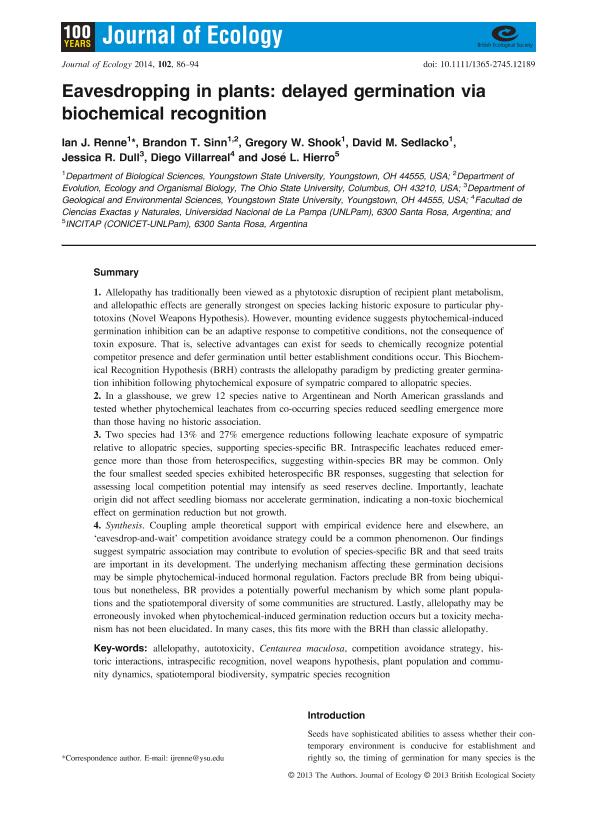Artículo
Eavesdropping in plants: delayed germination via biochemical recognition
Renne, Ian J.; Sinn, Brandon T.; Shook, Gregory W.; Sedlacko, David M.; Dull, Jessica R.; Villarreal, Diego; Hierro, Jose Luis

Fecha de publicación:
01/2014
Editorial:
Wiley
Revista:
Journal of Ecology
ISSN:
0022-0477
e-ISSN:
1365-2745
Idioma:
Inglés
Tipo de recurso:
Artículo publicado
Clasificación temática:
Resumen
Allelopathy has traditionally been viewed as a phytotoxic disruption of recipient plant metabolism, and allelopathic effects are generally strongest on species lacking historic exposure to particular phytotoxins (Novel Weapons Hypothesis). However, mounting evidence suggests phytochemical-induced germination inhibition can be an adaptive response to competitive conditions, not the consequence of toxin exposure. That is, selective advantages can exist for seeds to chemically recognize potential competitor presence and defer germination until better establishment conditions occur. This Biochemical Recognition Hypothesis (BRH) contrasts the allelopathy paradigm by predicting greater germination inhibition following phytochemical exposure of sympatric compared to allopatric species.
In a glasshouse, we grew 12 species native to Argentinean and North American grasslands and tested whether phytochemical leachates from co-occurring species reduced seedling emergence more than those having no historic association.
Two species had 13% and 27% emergence reductions following leachate exposure of sympatric relative to allopatric species, supporting species-specific BR. Intraspecific leachates reduced emergence more than those from heterospecifics, suggesting within-species BR may be common. Only the four smallest seeded species exhibited heterospecific BR responses, suggesting that selection for assessing local competition potential may intensify as seed reserves decline. Importantly, leachate origin did not affect seedling biomass nor accelerate germination, indicating a non-toxic biochemical effect on germination reduction but not growth.
Synthesis. Coupling ample theoretical support with empirical evidence here and elsewhere, an ‘eavesdrop-and-wait' competition avoidance strategy could be a common phenomenon. Our findings suggest sympatric association may contribute to evolution of species-specific BR and that seed traits are important in its development. The underlying mechanism affecting these germination decisions may be simple phytochemical-induced hormonal regulation. Factors preclude BR from being ubiquitous but nonetheless, BR provides a potentially powerful mechanism by which some plant populations and the spatiotemporal diversity of some communities are structured. Lastly, allelopathy may be erroneously invoked when phytochemical-induced germination reduction occurs but a toxicity mechanism has not been elucidated. In many cases, this fits more with the BRH than classic allelopathy.
Archivos asociados
Licencia
Identificadores
Colecciones
Articulos(INCITAP)
Articulos de INST.D/CS D/L/TIERRA Y AMBIENTALES D/L/PAMPA
Articulos de INST.D/CS D/L/TIERRA Y AMBIENTALES D/L/PAMPA
Citación
Renne, Ian J.; Sinn, Brandon T.; Shook, Gregory W.; Sedlacko, David M.; Dull, Jessica R.; et al.; Eavesdropping in plants: delayed germination via biochemical recognition; Wiley; Journal of Ecology; 102; 1; 1-2014; 86-94
Compartir
Altmétricas



